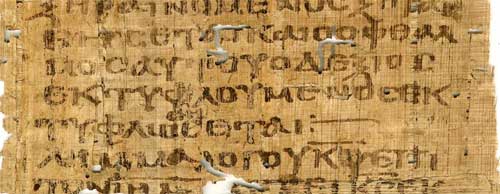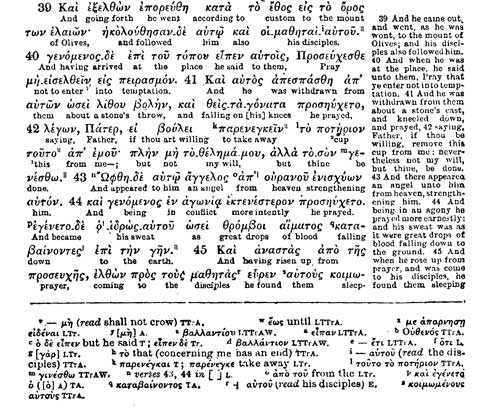Most of us are aware that we don’t have any original texts of the books of the bible. There are a number of reasons for this. One reason is that there were book destructions, i.e., book burnings done by governments who wanted to remove what they considered offensive religions from their society. One such destruction was in 303 AD where the Roman Emperor, Diocletian, ordered the destruction of all books considered sacred by the Christians. He must have done a good job because there are very few remaining examples of texts from before that date. Another reason is that texts wear out. In fact, how the Bible was copied and transmitted through the ages contributed to variations in the text. The books were handwritten and copied throughout the ages until the printing press was invented. As you might expect there were errors in this process.
Some manuscripts were copied by friends or members of a congregation, but scribes were professionals who both took dictation and put the words to paper, or copied existing texts. Being a scribe was a profession going back thousands of years:
and one man in the midst of them clothed in linen, with a writer’s inkhorn by his side. (Ezekiel 9:2)
Manuscripts were not always copied where one person viewed an existing text and copied it, and verified it at each step in the process. Manuscripts were sometimes copied in a mass production process where one person read the text and a group of scribes wrote what they heard. As you can imagine this allowed for errors from different causes; homophones (words that sound the same but mean different things), lapses of attention, spelling errors, etc. Sometimes scribes wrote on the margins of texts and later scribes inserted these additions into the text. Some texts were changed deliberately as scribes tried to harmonize similar passages, eliminate apparent discrepancies, adapt the text for liturgical purposes, or deliberately make doctrinal changes.[i]
Also, remember that writing rules were different in ages past. For one thing, there was no punctuation or spacing as we have now:
The above is an example of an Uncial text which was the method used from the third century B.C. to the Tenth Century A.D.[ii] Notice that it has a string of one block Greek letter after another. This is called scriptia continua, continuous letters with no spaces between words or sentences. Later manuscripts, starting around the eighth century, are called minuscules, which had a cursive running style. At about the same time as the appearance of minuscule, we find punctuation starting to be added. Heading and titles were first added by Stephan Langton into the Latin Bible about the beginning of the thirteenth century. All of these “improvements” allow for the possibility of interpretative error, as scribes and especially translators depended on their theology for understanding the text they were copying or translating.
In terms of translation remember that there is no such thing as a word for word translation. In Greek, for example, we have four words for love: phileo, eros, storge, and agapao, all translated into the English word love. Phileo is brotherly love, eros is sexual attraction and love, storge is familial affection, and agapao is the selfless love manifested by God to us that we are called to manifest ourselves. In English, they are all translated as love, but in Greek, they have distinctly different meanings. When you read love in an English translation you may not know which word and meaning it is in Greek. So translations are by nature an approximation of the meaning of the original text rather than an exact meaning of it.
It is estimated that there are hundreds of thousands of differences between the thousands of manuscripts from which we get the Bible. Most of the mistakes are harmless typos. Some, however, are more serious, and there are even apparent forgeries. We will look at some apparent forgeries in a later article.
As manuscripts wore out they were replaced with copies, some from the same manuscript, others from perhaps an earlier version. In any event, it becomes easy to see why by the time modern bible versions were being translated it was from copies of copies of copies.
Also, in fact, when a translator translates a text, it isn’t from a single manuscript. In order to attempt to get to the original meaning of a text, scholars compare different manuscripts and compile them into a text that a compilation of many texts. In my 1974 edition of the Interlinear Greek – English New Testament, it compares the English King James Version to the Received Text from which it was translated, but compares that to the following lists of texts[iii]:
| Symbol | Author | Year Created |
| E | Elzevir | 1624 |
| G | Griesbach | 1805 |
| L | Lachman | 1842-1850 |
| T | Tischendrof, eighth edition | 1865-1872 |
| Tr | Tregelles | 1857-1872 |
| A | Alford, vols; i,ii,iii,iv | 1868, 1871,, 1865, 1862-1870 |
| W | Wordsworth | 1870 |
Here is a sample of the Interlinear text[iv]:
The above shows the layout of the Interlinear with the top left showing the Greek text of the Received Text with the translation below it. To the right is the corresponding text in the KJV. In Greek, you will see symbols such as:
| Symbol | Meaning |
| + | An addition to the text in the texts specified (see table above for letter meaning) |
| – | Text is omitted in the texts specified |
| [ ] | In the text, there is no corresponding Greek word |
| [ ] | In the notes, the reading is doubtful |
| || | Indicates how far the variation in the Greek text extends |
The above page does not show an unusual amount of variation, which you can see is substantial. There are numerous variations in just about every chapter.
As an example, if you look at the beginning of verse 43 above (in the image of the Interlinear text) you will see an “n”. In the notes below, it reads, “nverses 43, 44 in [ ] L”. This means that verses 43 and 44 are missing in the Lachman text. Some scholars believe that since these verses describe Jesus “sweating blood” making Jesus look weak and out of control (in some people’s opinion) which is inconsistent with other passages describing him in the Gospels, some scribes omitted them. This is an example of scribes changing the text for doctrinal reasons.
[i] THE MAKING OF THE NEW TESTAMENT, Origin, Collection, Text & Canon, Arthur G. Patzia, InterVarsity Press, Downers Grove, Illinois, 1995, P. 168-143
[iii] INTERLINEAR GREEK – ENGLISH NEW TESTAMENT, George Ricker Berry, Phd., Zondervan, Grand Rapids, Sixteenth Printing,1974, p. 0
Edited 2/21/2022
© copyright 2011-2022 Mark W Smith, All rights reserved.

